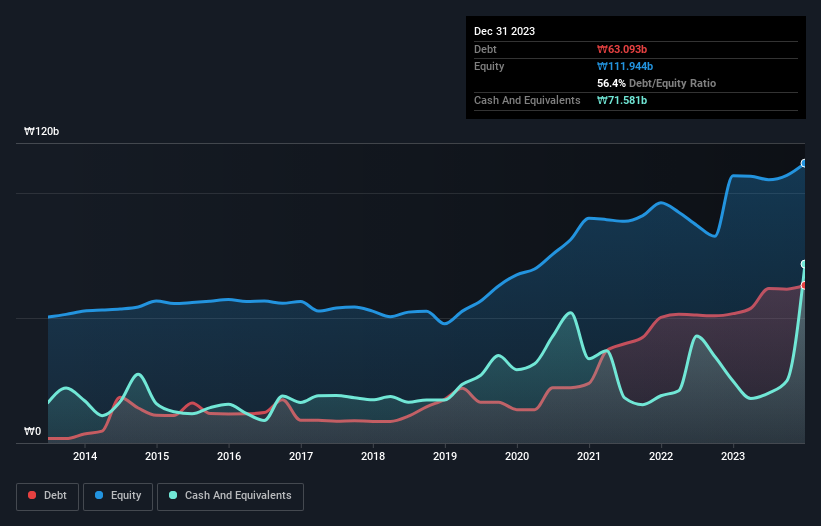Stock Analysis
- South Korea
- /
- Machinery
- /
- KOSDAQ:A104460
DYPNFLtd (KOSDAQ:104460) Seems To Use Debt Quite Sensibly

The external fund manager backed by Berkshire Hathaway's Charlie Munger, Li Lu, makes no bones about it when he says 'The biggest investment risk is not the volatility of prices, but whether you will suffer a permanent loss of capital.' So it might be obvious that you need to consider debt, when you think about how risky any given stock is, because too much debt can sink a company. We note that DYPNF Co.,Ltd (KOSDAQ:104460) does have debt on its balance sheet. But the more important question is: how much risk is that debt creating?
When Is Debt Dangerous?
Generally speaking, debt only becomes a real problem when a company can't easily pay it off, either by raising capital or with its own cash flow. If things get really bad, the lenders can take control of the business. However, a more common (but still painful) scenario is that it has to raise new equity capital at a low price, thus permanently diluting shareholders. Of course, plenty of companies use debt to fund growth, without any negative consequences. When we think about a company's use of debt, we first look at cash and debt together.
See our latest analysis for DYPNFLtd
How Much Debt Does DYPNFLtd Carry?
As you can see below, at the end of December 2023, DYPNFLtd had ₩63.1b of debt, up from ₩51.8b a year ago. Click the image for more detail. However, it does have ₩71.6b in cash offsetting this, leading to net cash of ₩8.49b.

A Look At DYPNFLtd's Liabilities
We can see from the most recent balance sheet that DYPNFLtd had liabilities of ₩140.2b falling due within a year, and liabilities of ₩39.1b due beyond that. On the other hand, it had cash of ₩71.6b and ₩32.0b worth of receivables due within a year. So its liabilities outweigh the sum of its cash and (near-term) receivables by ₩75.7b.
DYPNFLtd has a market capitalization of ₩237.3b, so it could very likely raise cash to ameliorate its balance sheet, if the need arose. However, it is still worthwhile taking a close look at its ability to pay off debt. While it does have liabilities worth noting, DYPNFLtd also has more cash than debt, so we're pretty confident it can manage its debt safely.
Notably, DYPNFLtd made a loss at the EBIT level, last year, but improved that to positive EBIT of ₩8.9b in the last twelve months. There's no doubt that we learn most about debt from the balance sheet. But ultimately the future profitability of the business will decide if DYPNFLtd can strengthen its balance sheet over time. So if you're focused on the future you can check out this free report showing analyst profit forecasts.
Finally, a business needs free cash flow to pay off debt; accounting profits just don't cut it. While DYPNFLtd has net cash on its balance sheet, it's still worth taking a look at its ability to convert earnings before interest and tax (EBIT) to free cash flow, to help us understand how quickly it is building (or eroding) that cash balance. Happily for any shareholders, DYPNFLtd actually produced more free cash flow than EBIT over the last year. That sort of strong cash conversion gets us as excited as the crowd when the beat drops at a Daft Punk concert.
Summing Up
While DYPNFLtd does have more liabilities than liquid assets, it also has net cash of ₩8.49b. The cherry on top was that in converted 401% of that EBIT to free cash flow, bringing in ₩36b. So we are not troubled with DYPNFLtd's debt use. Over time, share prices tend to follow earnings per share, so if you're interested in DYPNFLtd, you may well want to click here to check an interactive graph of its earnings per share history.
Of course, if you're the type of investor who prefers buying stocks without the burden of debt, then don't hesitate to discover our exclusive list of net cash growth stocks, today.
Valuation is complex, but we're helping make it simple.
Find out whether DYPNFLtd is potentially over or undervalued by checking out our comprehensive analysis, which includes fair value estimates, risks and warnings, dividends, insider transactions and financial health.
View the Free AnalysisHave feedback on this article? Concerned about the content? Get in touch with us directly. Alternatively, email editorial-team (at) simplywallst.com.
This article by Simply Wall St is general in nature. We provide commentary based on historical data and analyst forecasts only using an unbiased methodology and our articles are not intended to be financial advice. It does not constitute a recommendation to buy or sell any stock, and does not take account of your objectives, or your financial situation. We aim to bring you long-term focused analysis driven by fundamental data. Note that our analysis may not factor in the latest price-sensitive company announcements or qualitative material. Simply Wall St has no position in any stocks mentioned.

Simply Wall St
About KOSDAQ:A104460
DYPNFLtd
DYPNF Co.,Ltd manufactures and sells powder transport equipment in South Korea, the United States, the Middle East, Southeast Asia, Europe, and internationally.
High growth potential with excellent balance sheet.
